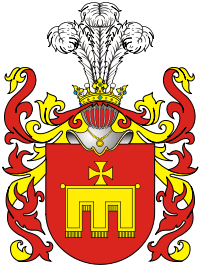Jarosław Dąbrowski
| Jarosław Żądło-Dąbrowski z Dąbrówki h. Radwan | |
|---|---|
 General Jarosław Dąbrowski | |
| Nickname | Iaroslav Dombrovski |
| Born |
13 November 1836 Żytomierz, Poland (now Ukraine) |
| Died |
23 May 1871 (aged 34) Paris, France |
| Allegiance | Poland (Russian Empire), Paris |
| Service/branch | Russian Army, Communards |
| Years of service |
Russian Army: 1845-1862 Communards: March–May 1871 |
| Rank | Commander-in-Chief |
| Commands held | Paris Commune (Communards) |
| Battles/wars | January Uprising, Paris Commune |
Jarosław Żądło-Dąbrowski z Dąbrówki h. Radwan (Polish pronunciation: [jaˈrɔswaf dɔmˈbrɔfskʲi]; 13 November 1836 – 23 May 1871) was a Polish left-wing independence activist and general. Supporter of the Paris Commune. (Zdrada 1973, p. 9). He was a participant in the January Uprising and was one of the leaders [1] of the "Red" faction among the insurrectionists as a member of the Central National Committee (Komitet Centralny Narodowy) and the Provisional National Government (Tymczasowy Rząd Narodowy).
Biography
Youth
Dąbrowski was born in Żytomierz, in what is now Ukraine. He was the offspring of the old Polish noble family Żądło-Dąbrowski z Dąbrówki h. Radwan. He bore the Clan Radwan arms. His father was Wiktor Żądło-Dąbrowski of Dąbrówka, coat-of-arms Radwan. His mother was Zofia née Falkenhagen-Zaleska. (Zdrada 1973, pp. 9–10).
Military career
In 1845 at age 9, Dąbrowski joined the Russian army, enrolling in the officer training corp at the Brest-Litovsk Fortress, where he spent 8 years. He graduated from the St. Petersburg Cadet Corps in 1855. He fought as a Russian officer against mountaineer uprisings in the Caucasus. In 1859 he enrolled in the General Staff Academy in St. Petersburg. There he was one of the leaders of the secret "Officers' Committee of the First Army". Members included several hundred Russian and Polish officers, cooperating with the revolutionary "Zemlya i Volya" (Land and Liberty) movement. (Lerski 1996, p. 103). He became involved in the preparation of the January Uprising, but was arrested on 14 August 1862, and exiled to Siberia for his participation in a plot against the Tsar, Alexander II. In 1865, he escaped and fled to France.
On the barricades in Paris

Legacy
Poland
Several schools and roads are named after him in Poland; among them most notable is The Military Technical Academy in Warsaw, Poland,[4] named in memorial of him.
Polish 200-Złoty Banknote Printed in 1976 (Obverse): (Reverse):Spanish Civil War
In the Spanish Civil War (1936–1939), - the Dabrowski Battalion and various Brigade-strength units (known in Polish as the Dąbrowszczacy) - were named in his honour. See Polish Volunteers in the Spanish Civil War.
Dąbrowski Battalion Flag:
Ukraine
Memorial -- JAROSŁAW DĄBROWSKI House; Zhytomyr, Ukraine, Sculptor Josef Tabachnyk:
10014 Zhytomyr
Zhytomyrs'ka Oblast
UKRAINE
Footnotes
- ↑
- ↑ Petit Robert: Noms Propres
- ↑ Horne, Alistair (165). The Fall of Paris. New York: St. Martin's Press. p. 380.
- ↑ "Wojskowa Akademia Techniczna im. Jarosława Dąbrowskiego", Ogólnopolski Katalog Szkolnictwa www.szkolnictwo.pl. Retrieved on 14 June 2007.
See also
References
- Billington, James H. (1980), Fire in the Minds of Men: Origins of the Revolutionary Faith, New York: Basic Books.
- Lerski, Jerzy J. (1996), Historical Dictionary of Poland, 966-1945, Westport, Connecticut: Greenwood Press.
- Zdrada, Jerzy (1973), JAROSŁAW DĄBROWSKI: 1836–1871, Kraców, POLSKA: Wydawnictwo Literackie.
External links
| Wikimedia Commons has media related to Jarosław Dąbrowski. |
|
